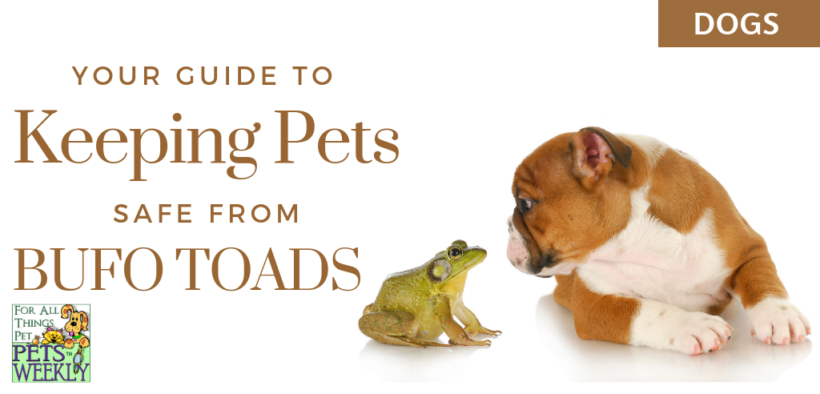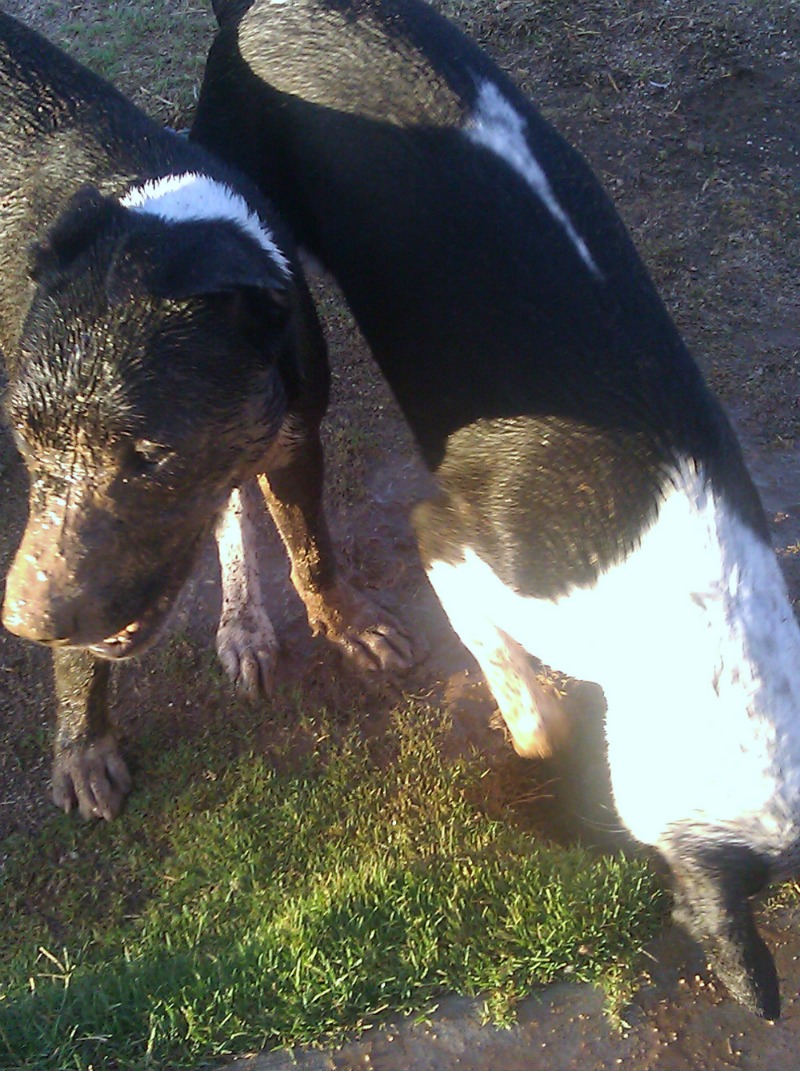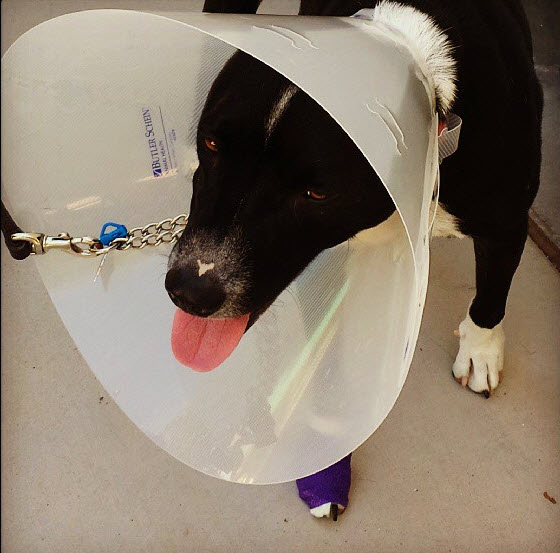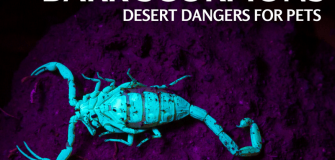Desert Dangers: Toads
Share

Arizona. It’s one of the most hostile, yet hauntingly beautiful places in the world. But our Sonoran desert is filled with danger for us and to our pets. One of these dangers is the Sonoran Desert Toad.
These toads are commonly known as the Sonoran Desert Toad, the Colorado River Toad, or just “bufo toad“. Their scientific names are Ollotis alvaria and Bufo alvarius.
Some 16 species of Bufo toads are found around the world. Bufo alvarius (Colorado River toad) are primarily found In the southwestern United States, Northern Mexico, Central Mexico, and South America. Bufo marinus is found in Florida and Hawaii. These toads go by many names, including the Colorado River Toad, Sonoran Desert Toad, and the Cane Toad (Bufo alvarius).
Should your dog “mouth” one of them, there is a huge potential for problems ranging from hallucinations and trembling to seizures or even death.
Here’s what you need to know about the Sonoran Desert Toad and your pets.
About The Sonoran Desert Toad
You’ll find Sonoran Desert Toads all year long in the Phoenix area (especially if you live near areas that have permanent water sources, such as pools, ponds or lakes). But, the desert toad is most active during our Monsoon season (which is technically between June 15 – September 30).
The Sonoran Desert Toad lives underground in rodent holes or some other underground retreat. They spend their days helping Arizonans manage a huge population of bugs – like crickets, cockroaches, spiders – even small lizards and mice!
Toads usually come out during or just after a monsoon rain. Breeding generally occurs on a night within 2-3 days of a rainfall events greater than an inch.
They lay up to 8,000 eggs at one time! This makes it challenging to manage the little ones (especially when they lay eggs in your pool).
These toads are known for coming outdoors at night. When they are not active (in winter months), they live in underground rodent burrows. But whenever we receive rainfall of more than an inch or high humidity levels for more than a few days, you can expect them to pop up in your yards like mushrooms.
They love being in slow-moving streams, temporary pools of water (like after it rains and then floods), or any area that has lakes (especially on golf courses).
The Sonoran toad is one of Arizona’s largest toads. It can grow to over 7.5 inches in length but they also come in very small sizes (less than an inch), so it’s very tough sometimes to know what your pet got hold of.
However, the symptoms your pets will experience are unforgettable.
What Happens When Dogs Mouth Toads
Dogs love to chase these little guys down and mouth or bite at them. I’m not sure what their fascination with the little guys are, but you can see our two committed to digging in mud and trying to track them down below (don’t worry – we don’t let them get them access the toads)! Not only is it very dangerous for them, but our toads are protected.

These toads are illegal to possess or move from the state in the states in which I. alvarius is (or was) indigenous. That includes California, Arizona, and New Mexico.
The Arizona Game and Fish Department is very clear about the law in Arizona: “An individual shall not… export any live wildlife from the state; 3. Transport, possess, offer for sale, sell, sell as live bait, trade, give away, purchase, rent, lease, display, exhibit, propagate… within the state…”
In other words, don’t mess with them…
How Pets Get Injured from Toads
The Sonoran toad secretes a toxin that actually has many valid uses – including protection for the toad. Its toxin contains 5-MeO-DMT (a psychedelic) and bufotenin (a type of hallucinogenic).
These toads secrete a toxin that is transferred to your dogs and cats when they “mouth” the toads. The toxin is a self-defense mechanism for the toads, but can be deadly to dogs.
These toads obviously like water and can perch on your pets outdoor water bowl long enough to leave a toxin behind, which can also cause your pets to have a reaction.
Toad Poisoning in Pets
Dogs quickly learn that the toxin excreted from these toads not only tastes horrible, but results in horrible effects. The toxin acts like a hallucinogenic to the animal. You’ll know your dog found one within seconds of the dog “mouthing” the toad.
Symptoms include:
- Drooling
- Slobbering foam
- Shaking head
- Loss of coordination
- Tearing of the eyes
- Apparent blindness (staggering, etc)
- Bright red gums
- Elevated heartbeat
- High fever
- Seizures

Treatment for pets who mouth toads
The first thing to do is remove the toxin from your pets mouth and face.
Flush your dog’s mouth out (carefully – please don’t drown your dog!) with large amounts of water. For our big dogs, we used a hose and directed the stream away from the mouth (never down the throat).
Do this carefully. Your dog may be experiencing hallucinations and other discomfort. This means they can easily pose a threat as panic sets in.
The goal is to remove the toxins from your pets mouth as soon as possible. Your dog should follow up with the veterinarian immediately.

Is This Considered An Emergency?
We always advocate to see your vet immediately. You should always err on the side of caution, “Yes, you need to get your pet to a vet.”
But keep in mind that each dog will react differently. Here’s why:
Some larger dogs will have very little reaction other than foaming at the mouth if you can remove the toxin early. It won’t be pleasant for you or them. However, they will probably survive it just fine. But, you never know what the long term effects will be. Some animals have not had the toxin removed quickly enough, and gone into shock and died.
Make no mistake – this toad’s toxin is deadly. On top of that, there is no antidote for the toxin. This is why it’s so important to get supportive care in place immediately.
What Can A Veterinarian Do?
Treatment focuses on supportive care and may include these options as well as others. You should plan on having your pet staying at least one night with your veterinarian, although treatment can vary greatly depending on the pet’s reaction.
Your vet will be able to supply anti-arrhythmic drugs, sedation (if needed), atropine and sub-cutaneous fluids. With supportive care and quick action, even your smallest pets have a very excellent chance of surviving the toxin of the bufo toad.
- Cardiac glycoside effects: Drugs such as atropine, phenytoin and lidocaine may be administered to manage bradycardia (abnormally slow pulse) and other cardiac irregularities.
- Hallucinogenic effects: Sedation may be required to keep the pet calm until the poison is expelled from the body.
- Emesis (vomiting) may be indicated if there was a recent substantial ingestion and the dog is sufficiently alert. Repeated oral charcoal doses (every 2-6 hours) may help reduce the duration of poisoning.
- Elevated Serum Levels: Intravenous insulin, glucose, and sodium bicarbonate may be required to combat life-threatening hyperkalemia (elevated serum pH levels).
- Toxicity reduction: Cholestyramine may enhance elimination of bufagin (one of the several bufo venom toxins).
Bottom line, these toads are very toxic. Get your pet’s mouth flushed as soon as possible and take your pet to the emergency veterinarian immediately.










